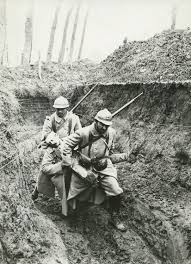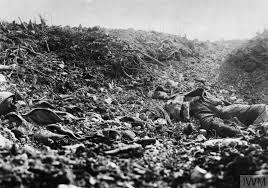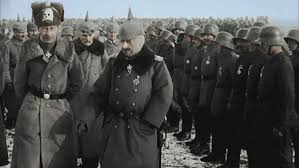Who and Where was the battle
Who?
German plan of attack
The 5th Army divided the attack front into areas, A occupied by the VII Reserve Corps, B by the XVIII Corps, C by the III Corps and D on the Woëvre plain by the XV Corps. The preliminary artillery bombardment was to begin in the morning of 12 February. At 5:00 p.m., the infantry in areas A to C would advance in open order, supported by grenade and flame-thrower detachments. Wherever possible, the French advanced trenches were to be occupied and the second position reconnoitred, for the artillery fire on the second day. Great emphasis was placed on limiting German infantry casualties, by sending them to follow up destructive bombardments by the artillery, which was to carry the burden of the offensive in a series of large "attacks with limited objectives", to maintain a relentless pressure on the French. The initial objectives were the Meuse Heights, on a line from Froide Terre to Fort Souville and Fort Tavannes, which would provide a secure defensive position from which to repel French counter-attacks. Relentless pressure was a term added by the 5th Army staff and created ambiguity about the purpose of the offensive. Falkenhayn wanted land to be captured, from which artillery could dominate the battlefield and the 5th Army wanted a quick capture of Verdun. The confusion caused by the ambiguity was left to the corps headquarters to sort out.
Control of the artillery was centralised by an Order for the Activities of the Artillery and Mortars, which stipulated that the corps Generals of Foot Artillery were responsible for local target selection, while co-ordination of flanking fire by neighbouring corps and the fire of certain batteries, was determined by the 5th Army headquarters. French fortifications were to be engaged by the heaviest howitzers and enfilade fire. The heavy artillery was to maintain long-range bombardment of French supply routes and assembly areas; counter-battery fire was reserved for specialist batteries firing gas shells. Co-operation between the artillery and infantry was stressed, with accuracy of the artillery being given priority over rate of fire. The opening bombardment was to build up slowly and Trommelfeuer (a rate of fire so rapid that the sound of shell-explosions merged into a rumble) would not begin until the last hour. As the infantry advanced, the artillery would increase the range of the bombardment to destroy the French second position. Artillery observers were to advance with the infantry and communicate with the guns by field telephones, flares and coloured balloons. When the offensive began, the French were to be bombarded continuously, harassing fire being maintained at night.
French defensive preparations
In late January 1916, French intelligence had obtained an accurate assessment of German military capacity and intentions at Verdun but Joffre considered that an attack would be a diversion, because of the lack of an obvious strategic objective. By the time of the German offensive, Joffre expected a bigger attack elsewhere but ordered the VII Corps to Verdun on 23 January, to hold the north face of the west bank. XXX Corps held the salient east of the Meuse to the north and north-east and II Corps held the eastern face of the Meuse Heights; Herr had 8 1⁄2 divisions in the front line, with 2 1⁄2 divisions in close reserve. Groupe d'armées du centre had the I and XX corps with two divisions each in reserve, plus most of the 19th Division; Joffre had 25 divisions in the strategic reserve.French artillery reinforcements had brought the total at Verdun to 388 field guns and 244 heavy guns, against 1,201 German guns, two thirds of which were heavy and super heavy, including 14 in (360 mm) and 202 mortars, some being 16 in (410 mm). Eight specialist flame-thrower companies were also sent to the 5th Army.
Where and when?
In Verdún in the 21 February to 18 December 1916
Temas relacionados:
También te puede interesar
Esta web se reserva el derecho de suprimir, por cualquier razón y sin previo aviso, cualquier contenido generado en los espacios de participación en caso de que los mensajes incluyan insultos, mensajes racistas, sexistas... Tampoco se permitirán los ataques personales ni los comentarios que insistan en boicotear la labor informativa de la web, ni todos aquellos mensajes no relacionados con la noticia que se esté comentando. De no respetarse estas mínimas normas de participación este medio se verá obligado a prescindir de este foro, lamentándolo sinceramente por todos cuantos intervienen y hacen en todo momento un uso absolutamente cívico y respetuoso de la libertad de expresión.
No hay opiniones. Sé el primero en escribir.









